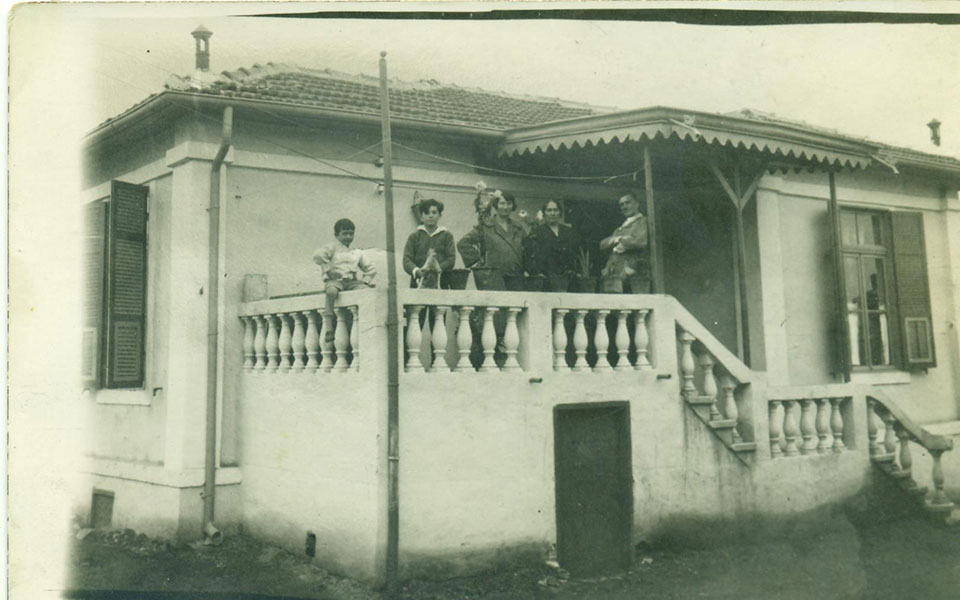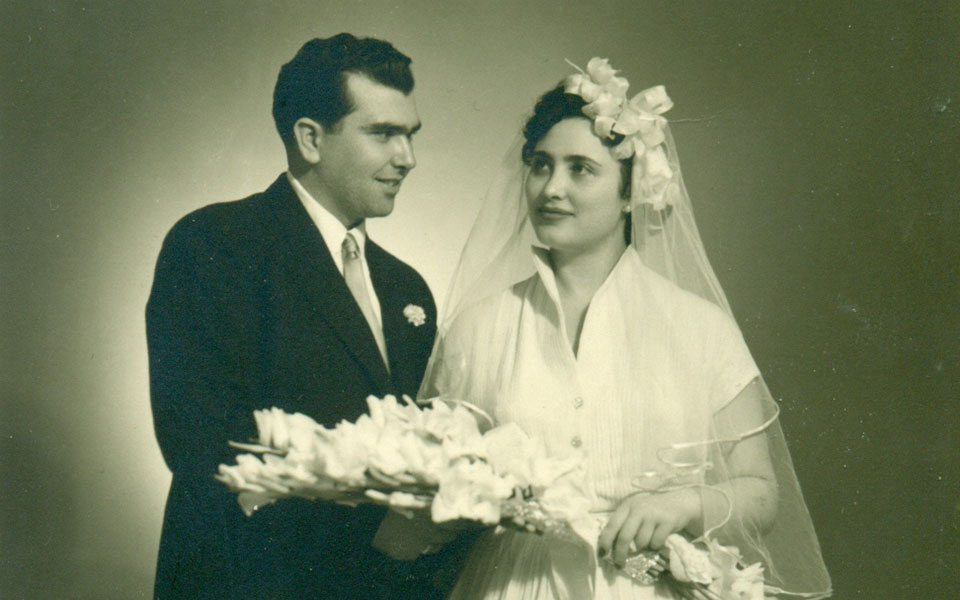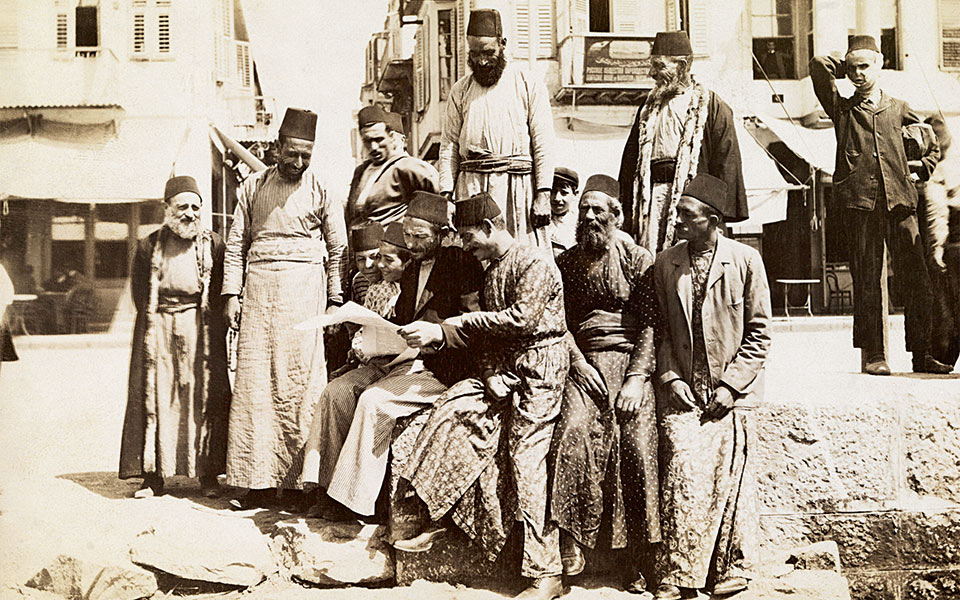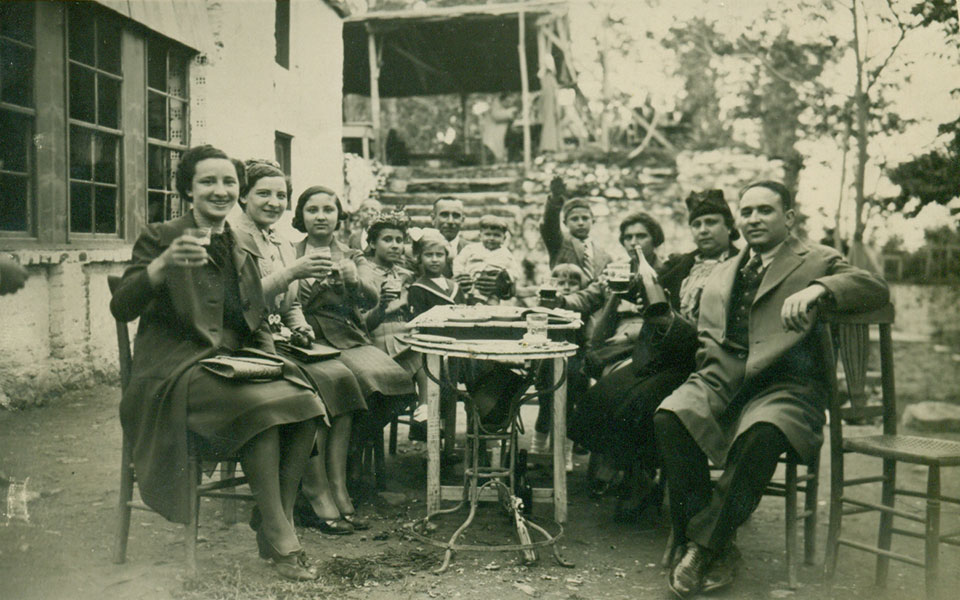When German troops occupied Thessaloniki in April 1941, the systematic persecution of the city’s Jews began almost immediately, eventually leading to their segregation into ghettos. In March 1943, the deportations began. Within a little over a year, a community that had been the cornerstone of Thessaloniki’s multicultural society for centuries was almost completely wiped out.
Leon Perahia was sent to Auschwitz. The Capon family was, at first, more fortunate; that same spring, as the deportations were in progress, Lina Capon’s sister, Alice, and her brother, Benjamin, were able to reach Athens, using false identities and various means of transportation. Lina and their parents, Hasdai and Vida, followed soon after.
The family first took refuge in an asylum by feigning insanity, as did some other Jews. They were betrayed, but when the police came, they were able to pay them off. Still, it no longer seemed safe, so they joined other family members already living in a villa that had been given to them by a business associate of Hasdai Capon. They lived there for nearly a year before being betrayed again.
Thirteen members of the extended family were deported, including Lina, her siblings and her parents. Their mother was killed on arrival at Birkenau, a fate that befell more than three-quarters of Thessaloniki’s Jews. Not long before liberation, Hasdai and Benjamin were sent to other camps, while Lina and Alice remained in Birkenau.

In January 1945, with the war’s end in sight, the Germans evacuated the death camps, hoping to kill as many Jews as possible by letting them die from exhaustion as they marched, before the Allies could reach them. When Birkenau was evacuated on January 18, Lina, feverish with typhoid, was in the infirmary. She fainted as they were being marched from the camp. A guard thought she was dead and kicked her aside. Alice was elsewhere and didn’t know what had happened to her sister. Hours later, Lina regained consciousness to find herself in an utterly deserted Birkenau.
Three kilometers away at Auschwitz, Leon and some friends had managed to hide during the evacuation. They had been factory workers, so they knew the camp’s layout and were also in fair physical condition. Armed with whatever they could find, they now took control of the camp where they were once prisoners, in case any Germans should return.
Two of the men, Jews from Holland, went to Birkenau in search of other survivors. They found Lina and told her there were other Thessaloniki Jews at Auschwitz. She gathered her strength, bundled herself in whatever she could find and set off with them through the snow, taking sips from a small bottle of Cardiazol – a heart medicine – to sustain her as she walked. When she arrived, she asked the prisoner-turned-guard, in German, if he knew where the Greeks were. He replied to her in Greek; the guard was Leon Perahia.
On January 27, the Russians liberated Auschwitz. They didn’t have the means to repatriate anyone, so the survivors were transported to the city of Chernivtsi (present-day Ukraine), where Leon and Lina fell in love. Six months later, they were sent by train to Bulgaria. Other Jews greeted them at the station offering soup and cigarettes. “Stay with us,” they urged them. “You won’t find any survivors in Thessaloniki.” But Lina and Leon could not be dissuaded; they still held out hope.
At a quarantine station set up near the Greek border at Sidirokastro, a woman from the Red Cross recognized Lina. She gave her excellent news: her father, brother and sister had survived. Alice had reunited with Benjamin at Bergen-Belsen, and their father had been liberated at Gross-Rosen; they had been living at home together in Thessaloniki for months.
Lina’s family had, for some time, been certain that Lina had died, after a woman from Thessaloniki had told them she had seen Lina being tossed aside as they were being marched from Birkenau. They had even said the Mourners’ Kaddish for her. The miraculous news was sent to them at once: Lina was alive and would soon return to them.
By June 1945, the Capon family had returned to their old rented apartment. Most of the city’s Jews were not as fortunate. Over 95 percent never made it back, and for nearly all of those who did return, there was no home to go back to: after the Jews were deported, the authorities redistributed most of their houses to refugees from Asia Minor and to those fleeing the violence in Thrace. With so many homes gone, communal housing was arranged in the buildings that were still at the disposal of the Jewish community. Leon, who had also lost his family home, was housed in a synagogue.
Back in Thessaloniki at last, Lina and Leon wished to marry at once. However, they met with a new obstacle. Lina’s father withheld his permission; there was, after all, still their difference in social class (the Capons were from a privileged class; the Perahias were not). And as it turned out, her father’s refusal wasn’t the only obstacle. No sooner was World War II over than the Greek Civil War, which had been brewing before the end of the German occupation, broke out in earnest. Leon was sent off to fight in 1947 and 1948. Some Jews perished in the civil war, but Leon came home safe. It was only after his return that Lina’s father was eventually persuaded to give his permission. In 1950, Lina and Leon were finally married.

Later in the 1950s, Leon and his brother, David, managed to reclaim their family home. They sold it, as David had decided to emigrate to the United States. Although Greece was the first country to pass a law allowing Jews to recover their properties, in practice, tracking down property deeds was difficult and costly. This led many other Jews to make fresh post-war starts elsewhere, some in the part of Palestine that would become the state of Israel in 1948, others in destinations closer to home, including Athens, feeling there was nothing left for them anymore in Thessaloniki, and yet others on distant continents.
Leon also thought of building a new life in Israel, but Lina wouldn’t hear of it. Being reunited with her family was a miracle, and it would have been unbearable to be parted from them again. Hasdai Capon lived with his daughter and son-in-law for the rest of his life; he was there when the family welcomed his granddaughters, part of a new generation of Thessaloniki Jews, into the world.
This story was narrated to the author by Lina and Leon’s daughter, Erika Perahia Zemour, who recently retired from the Jewish Museum of Thessaloniki.

THE RISE AND TRAGIC FALL OF A COMMUNITY
Some researchers believe there has been a Jewish presence in Thessaloniki since the founding of the city in 315 BC. Others suggest the first Jews may have come over from Alexandria, Egypt, in 140 BC. By the middle of the 1st century AD, we know there was an established community, as Apostle Paul addressed the congregation of a synagogue on his second missionary journey (Acts 17:1-9).
In 1492, 15,000-20,000 Jews who were fleeing the Spanish Inquisition settled in Thessaloniki.
When Thessaloniki became part of Greece in 1912, Jews were the city’s largest ethnic group, numbering over 61,000, with Muslims numbering 45,000 and Orthodox Greeks 40,000.
At its apex in the early 20th century, Thessaloniki’s Jewish community numbered about 80,000, representing half of the city’s population. The other half consisted of Muslims, Orthodox Greeks, Armenians, Slavs, Bulgarians and some other nationalities.
For 450 years, Ladino (Judeo-Spanish) was one of the city’s principal languages.
At the beginning of World War II, Thessaloniki’s Jewish community numbered over 50,000.
In 1946, the Jewish community numbered 2,400 members, about half of whom emigrated shortly after the war.
Today, there are about 1,000 Jews in Thessaloniki: 20 percent have their roots in the city, and the rest moved to Thessaloniki from the smaller surrounding cities of Kavala, Katerini, Larissa, Didymoteicho and others.
Thessaloniki now has a Jewish Museum, a new Jewish cemetery and two synagogues; the Jewish community also maintains an elementary school and a retirement home.












